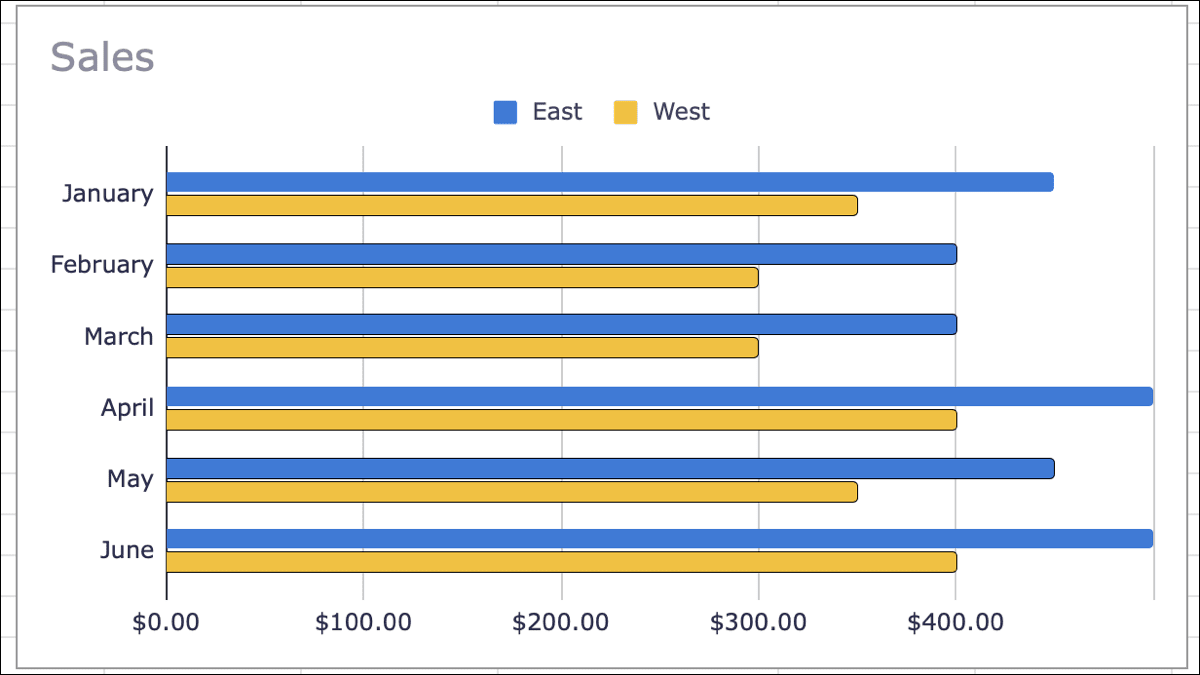Choosing a custom firmware for your router can be daunting. There are many recommended options online, and documentation for the actual firmware installation process tends to be sparse. Eliminate the jargon and acronyms that are thrown around, and before long, you'll be happy you're sticking with your router's stock firmware.

It doesn't have to be that difficult. Each of the three major open source firmwares—DD-WRT, Tomato, and OpenWRT—has its own strengths and weaknesses that make it ideal for a particular situation. You'll need to consider the features you need for your network and whether your router is supported by the firmware. These should be the most important factors you consider when making your choice.
Good to know: Before you get new router It is better to know the differences between Access Point and Repeater Mode.
What is custom firmware?
Before diving into the best router firmware options, let's break down what custom firmware actually is. After all, all routers come with firmware, but that doesn't mean you should stick with the default setup.
Routers include what is essentially a mini operating system embedded in the router's memory: ROM. Its purpose is to tell the router what to do and how to respond to all the different settings. Think of it as a smaller operating system capable of incredible things, like the Raspberry Pi OS for Raspberry Pi devices.
The default setting is sufficient for many users, but if you want additional features, you'll need to modify the firmware. This is where a custom firmware becomes essential. Some things a custom option can help with include:
- Improve the overall performance of your router. This is especially true if manufacturers don't update to the latest performance improvements.
- Better security. Unfortunately, many router manufacturers don't really care about firmware updates. Just like a computer's operating system, an outdated system opens you up to security threats. Custom firmware is typically updated frequently, and if it stops updating, you can switch to something else.
- Get a better interface. Beyond changing passwords, many users don't delve into their router's settings. If you have, though, you know that it's not always the best interface to navigate. Custom options are designed with the user experience in mind.
- Enjoy more features. Just because your router doesn't say it supports a feature doesn't mean it can't. All you need is the right firmware. This can include support for things like dynamic DNS, IPV6 support, and built-in VPNs.
- Set up Quality of Service (QoS). This allows your router to prioritize certain types of traffic over others so you get the speeds you need along with what matters most.
While many custom router firmware solutions are open source, you'll occasionally find one that isn't. However, with open source options, you also benefit from an entire community that helps support it—including finding and fixing bugs.
Note: Do not confuse a modem with a router. They are not the same thing.
DD-WRT
DD-WRT It's easily the biggest player when it comes to open source router firmware. It's been around long enough to establish itself, and it supports more routers than any other company, including low-priced ones. There are even people who They sell routers. It's safe to say that flashing DD-WRT on most routers is a good idea.
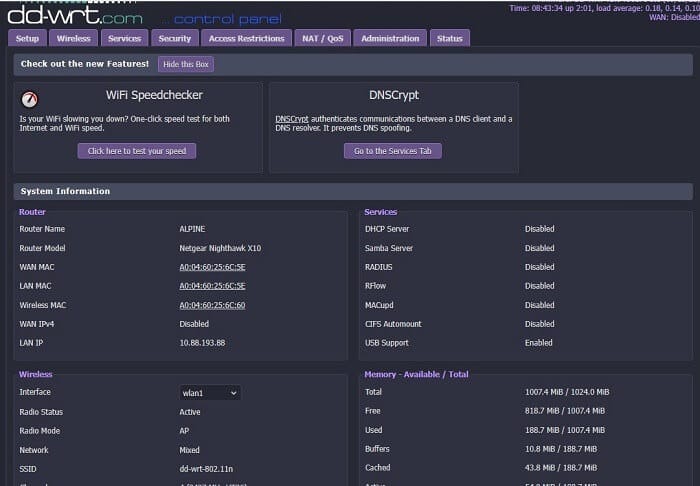
DD-WRT is a complete toolkit. It comes with almost everything you could want in a router, plus a lot you'll probably never see. This is both one of DD-WRT's biggest strengths and weaknesses. For those looking for maximum control, DD-WRT's array of options is a welcome breath of fresh air. If you're looking for a simple, straightforward approach, you'll have a hard time navigating DD-WRT.
Some additional features supported by DD-WRT include Wake on LAN for remote computer access and built-in QoS (Quality of Service). The latter helps better manage network traffic.
DD-WRT supports more routers than anyone else. As a result, they also have the largest community, so finding support for DD-WRT tends to be easier than for other custom router firmwares. Even routers that aren't officially supported tend to have community builds that are actively supported on the DD-WRT forums.
Positives
- Supports many routers
- huge community
- Built-in OpenVPN support
- Support quality of service
- A powerful set of options
- User-friendly interface
Negatives
- It can be overwhelming for new users.
- It may be difficult to find new versions for some routers.
Tomato
Prepare Tomato The most streamlined and easy-to-use firmware on this list, Tomato has been around for a while and has gained a reputation for being a straightforward, no-nonsense firmware that gives you the features you want and need without a lot of extra clutter. It's also earned a reputation for speeding up routers.
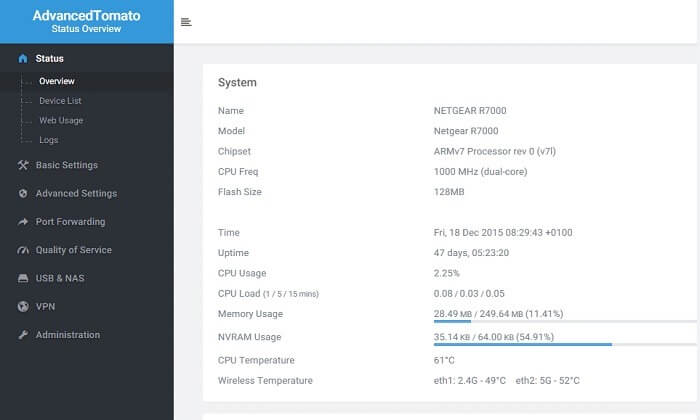
Recently, the AdvancedTomato project took the classic Tomato firmware from Shibby and created a sleek, modern GUI that allows real-time monitoring of vital statistics through animated graphs. The AdvancedTomato interface is one of its best selling points, making network management simpler and providing a more visually pleasing experience.
Tomato doesn't support as many routers as its competitors, and even the AdvancedTomato project has been somewhat fragmented in development. If your router is supported, this might be the option you're looking for, but you'll need to check first.
In 2021, Shabi announced that they had left the project. Although other developers have taken over, no new updates have been posted to the project since then. Shabi recommended FreshTomato As an alternative, which is still being actively updated.
Positives
- Modern interface
- high speeds
- Minimum footprint
- Built-in OpenVPN
- المراقبة في الوقت الحقيقي
Negatives
- smaller community
- Limited router support
OpenWRT
OpenWRT It's the oldest open-source router firmware project. It's a precursor to both DD-WRT and Tomato and has earned a reputation as a robust option with a wide range of features. OpenWRT, as it stands now, is actually a merger of the classic OpenWRT and LEDE.
OpenWRT may be the best choice for free software enthusiasts. It's the only one on this list that doesn't contain non-free binary options. While all three of these firmwares are based on Linux, OpenWRT is more like a traditional distribution.
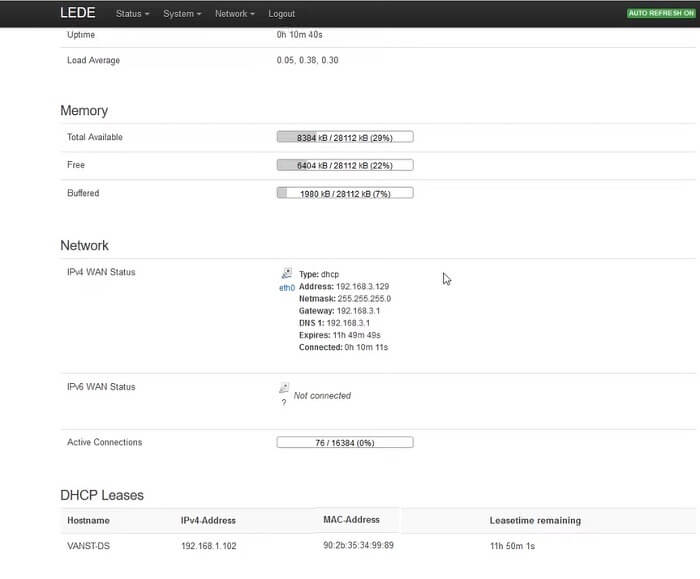
But this openness comes at a price. There are many routers that OpenWRT cannot fully support because they require non-free drivers to operate. The project's device table contains more than a few entries with partial support and no functional Wi-Fi, thanks to this. It lists Detailed equipment table Exactly what is not supported on certain routers.
OpenWRT offers more fine-grained control than DD-WRT, but this also comes at the price of simplicity. This firmware requires some knowledge to use properly and a bit more to make it worthwhile. OpenWRT is best for technical people who know exactly what they want.
Positives
- Tons of options
- Built-in OpenVPN
- Support quality of service
- Ability to drill at lower levels
Negatives
- Not easy to use
- More time to run
- Supports fewer routers
Consider other options
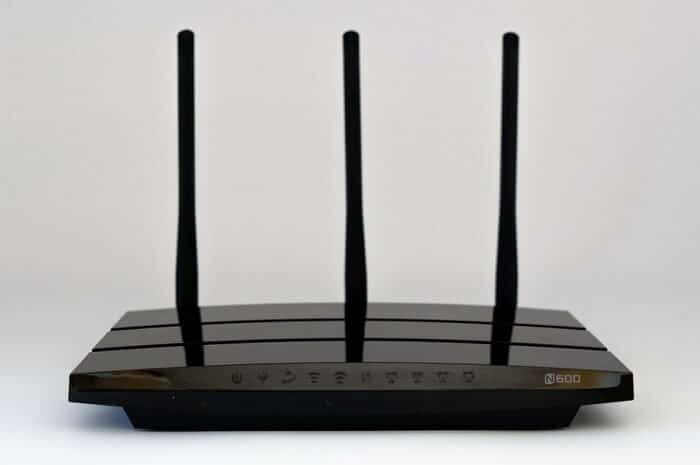
For most users, one of the above router firmware options is fine. However, you may be looking for something more specific, such as something for an older router or a specific feature. If so, you may want to consider one of the following firmware:
- Gargoyle – Based on OpenWRT, it offers both a graphical user interface and a command-line interface. It's primarily designed for older routers with Atheros and Broadcom chipsets. You'll also find built-in VPN, QoS, an adblocker, a Tor client, and network file sharing capabilities.
- Commotion Wireless – If you want to create your own mesh network using your existing routers, try this router firmware. It's also based on OpenWRT, giving you many of the same benefits but with built-in mesh networking.
- HyperWRT – This is specifically designed for the Linksys WRT54G and WRT54GS routers. It provides a powerful boost while preserving much of the original firmware.
- Sabai OS – This router firmware is based on Tomato and comes preloaded on Sabai VPN routers. It includes all the key features, such as QoS, DMZ, port forwarding, bridging, and more. It may be one of the easiest firmwares to manage, but only on certain routers.
Before choosing any firmware, make sure it's compatible with your current router. Also, make a note of the firmware you currently have so you can restore it if something doesn't work the way you want.
Best firmware for custom router
Overall, DD-WRT is the better choice for compatibility and features. However, both Tomato and OpenWRT are still worth using, especially with their easier-to-use and setup interfaces.
Whichever option you choose, you'll likely see a significant improvement over your router's stock firmware. You'll also get added functionality, such as OpenVPN client support, that will enable you to do even more with your network.
As an added bonus, all of these tend to be more secure than the manufacturer's firmware and receive more regular updates, if you choose to install them. Of course, when installing custom firmware, be sure to carefully follow the developers' instructions to minimize the risk of damaging your router.
Tip: Managing ports on your router is an important skill for running your home server.
Frequently Asked Questions
Q1. Is it safe to install custom firmware on my router?
answer. The most important thing to know before flashing a new firmware is whether it will void your router's warranty. If it's a new router and you want any chance of using the warranty if something stops working, don't use custom firmware.
If you don't do it right, you could ruin your router, leaving you with no choice but to buy a new one. If you don't want to risk a new router, buy a cheap one from a thrift store or discount store to practice on. It's better to spend an extra $10 to $15 practicing than to ruin a new one.
Q1. How do I install new firmware?
answer. First, download the correct firmware for your router. It's essential that you use the correct version, otherwise it won't work. If you're unsure of your router model, log in to the router's interface.
Some routers allow you to log in through your browser. Open a command prompt and type "ipconfig /all." Use your router's IP address in your browser to access the interface. Other routers require you to install an app to access the interface.
Once you have your model details, download the correct firmware. Then, log back into your router. Look for the "Firmware Upgrade" setting. The exact location varies depending on the router.
Q1. Will custom firmware help me get more out of my old router?
answer. Just like a computer, an old router can only do so much. If you have an older router, and the custom firmware you want is compatible, then yes, it may allow you to use your router for a longer period of time.
However, performance is only optimized based on your router's maximum capabilities, so it may still be slower than you'd like. There's no harm in trying it, though.




